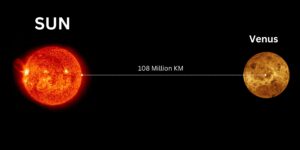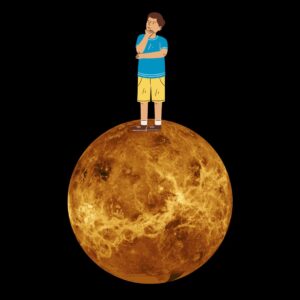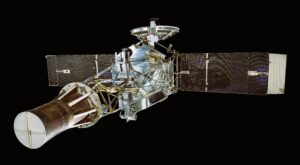- abaashishb7
- April 2, 2024
- 8:54 am
- No Comments
Venus Planet
शुक्र ग्रह
* Venus : The Fiery Jewel of Our Solar System
Venus, the second planet from the Sun and often called Earth’s “sister planet,” presents a
stark contrast with its scorching surface and thick, toxic atmosphere. Journey with us as
we delve into the mysteries of This Planet, exploring its extreme conditions and unique
features that set it apart in our solar system.
* Discovery of Venus
The discovery of This Planet, like many celestial objects, dates back to ancient times.
Here is a brief overview of how planet was discovered and how our understanding of it
has evolved over the centuries.
Ancient Observations
1:- Prehistoric Observations: due to its brightness, was easily visible to the
naked eye in the night sky. Prehistoric cultures likely observed and noted its
presence.
2:- Babylonian Astronomy: Babylonian astronomers, around the 17th century BCE, made
some of the earliest recorded observations of this planet. They associated it with their
goddess Ishtar.
3:- Greek and Roman Astronomy: The Greeks named the planet “Phosphorus” (meaning
“light-bringer”) when it appeared in the morning sky and “Hesperus” (meaning “evening
star”) when it appeared in the evening. The Romans later identified it with their goddess
of love, Venus.
4:- Astronomical Theories: Ancient astronomers, including Greek philosophers such as
Pythagoras and Aristotle, developed theories about the nature of Venus as it moved
across the sky. However, they did not understand that it was a planet orbiting the Sun.
* Heliocentric Model and Venus
1:- Copernican Revolution: In the 16th century, Nicolaus Copernicus proposed the
heliocentric model of the solar system, placing the Sun at the center with planets,
including Earth and Venus, orbiting around it.
2:- Galileo’s Observations: In the early 17th century, Galileo Galilei made telescopic
observations of this Venus, confirming that it went through phases similar to the
Moon.This provided evidence for the heliocentric model.
3:- Telescopic Observations: As telescopes improved, astronomers such as Johannes
Kepler and Giovanni Cassini made detailed observations of this planet, further
confirming its phases and orbit.
The discovery of this planet orbiting the Sun was a gradual process that evolved
over centuries. From ancient observations and associations with mythology to the
heliocentric model of the solar system, our understanding of Venus has deepened
with advancements in astronomy and space exploration.
Today, we continue to study Venus with spacecraft missions and telescopic
observations, uncovering its mysteries and shedding light on its extreme environment
and unique characteristics.
* Dimensions
The dimensions of Venus, the second planet from the Sun, can be described in
terms of its size, diameter, and mass. Here are the key dimensions of This Planet:
1:- Equatorial Diameter: Approximately 12,104 kilometers (7,521 miles)
2:- Polar Diameter: Approximately 12,104 kilometers (7,521 miles)
3:- Mean Diameter: Approximately 12,104 kilometers (7,521 miles)
4:- Circumference: Approximately 38,025 kilometers (23,627 miles)
5:- Surface Area: Approximately 460.2 million Sq. kilometers (177.7 million Sq. miles)
6:- Volume: Approximately 928.4 billion Cubic kilometers (222.4 billion cubic miles)
7:- Mass: Approximately 4.87 x 10^24 kilograms (0.82 Earth masses)
* Key Facts of Venus
1:- Distance from the Sun: This Planet orbits the Sun at an average distance of about 67
million miles (108 million kilometers).
2:- Orbital Period: A year on Planet (the time it takes to orbit the Sun once) is equivalent
to about 225 Earth days.
3:- Rotation: This Planet rotates very slowly on its axis, taking about 243 Earth days to
complete one rotation. Interestingly, this planet rotates in the opposite direction to
most other planets, a phenomenon known as retrograde rotation.
4:- Surface Temperature: This Planet experiences extreme surface temperatures due to
its thick atmosphere and greenhouse effect. Daytime temperatures on this planet can
reach up to 900 degrees Fahrenheit (475 degrees Celsius), making it the hottest planet
in our solar system.
5:- Atmosphere: This planet has a dense and toxic atmosphere composed mainly of
carbon dioxide (about 96.5%) with traces of nitrogen and other gases. The
atmospheric pressure on this planet is about 92 times that of Earth’s, similar to the
pressure found 3,000 feet (900 meters) underwater on Earth.
6:- Cloud Cover: The planet is enveloped in thick clouds of sulfuric acid, which reflect
much of the sunlight that reaches this planet back into space. These clouds create a
greenhouse effect that traps heat, contributing to the extreme temperatures on the
planet’s surface.
7:- Surface Features: This Planet has a relatively young surface with extensive volcanic
plains, mountains, and large impact craters. The lack of plate tectonics means that
planet has fewer surface features like mountains and valleys compared to Earth.
8:- Magnetic Field: This Planet has a very weak magnetic field, about 0.000015 times
that of Earth’s magnetic field. It is often described as “induced” rather than intrinsic,
meaning it is likely generated by interactions between the solar wind and this planet’
atmosphere rather than a dynamo effect from a liquid metal core like Earth’s.
9:- Lack of a Liquid Iron Core: Unlike Earth, This Planet likely does not have a liquid iron
core capable of generating a strong magnetic field. The lack of plate tectonics and a
significant magnetic field suggests that Planet interior is not convecting in the same
way as Earth’s.
* Composition of Venus
Atmosphere
1:- Main Component: The atmosphere of this planet is predominantly composed of
carbon dioxide (about 96.5%), making it a thick and dense atmosphere.
2:- Traces of Gases: There are also traces of nitrogen, sulfur dioxide, water vapor, and
other gases in this planet’s atmosphere.
3:- Clouds: This Planet’s atmosphere is shrouded in thick clouds of sulfuric acid droplets,
which reflect sunlight back into space and contribute to its extreme greenhouse
effect.
Surface
1:- Rocky Terrain: This Planet’s surface is rocky and heavily cratered, similar to the
Moon’s surface.
2:- Volcanic Features: It has vast volcanic plains, indicating significant volcanic activity
in the past. Some volcanoes on this planet are among the largest in the solar system.
3:- Mountains: This Planet has mountains and highlands, with Maxwell Montes being the
highest mountain on the planet.
4:- Impact Craters: Although Venus has impact craters, they are relatively few
compared to other bodies in the solar system. This is due to the planet’s thick
atmosphere, which burns up smaller meteoroids before they reach the surface.
5:- Lava Flows: Extensive lava flows cover much of this Planet’s surface, suggesting that
volcanic activity has played a significant role in shaping the planet’s geology.
* Structure of Venus
Core
1:- Size: The core of This Planet is estimated to be about 3,000 to 3,500 kilometers (1,900
to 2,200 miles) in diameter.
2:- Composition: The core is believed to be primarily composed of iron and nickel,
similar to Earth’s core.
3:- State: The core of This Planet is likely solid due to the lack of a strong magnetic field
generated by a liquid metal core.
Mantle
1:- Thickness: The mantle of This Planet is estimated to be around 3,000 kilometers
(1,900 miles) thick.
2:- Composition: It is composed of silicate rocks, similar to Earth’s mantle.
3:- Convective Activity: The mantle of This Planet is thought to have convective activity,
which may have contributed to past volcanic eruptions and the resurfacing of the
planet.
Crust
1:- Thickness: The crust of This Planet is estimated to be around 50 to 70 kilometers (31
to 44 miles) thick.
2:- Composition: This Planet’s crust is composed of basaltic rock, similar to the oceanic
crust on Earth.
3:- Tectonic Activity: Unlike Earth, This Planet does not have plate tectonics. Instead, it
may have undergone periods of global resurfacing due to volcanic activity.
* What Would Happen if a Human Were to Enter Venus
Extreme Surface Conditions
1:- Extreme Heat: This Planet has an average surface temperature of about 462 degrees
Celsius (864 degrees Fahrenheit), which is hotter than the surface of Mercury,
despite being farther from the Sun. This extreme heat is due to the thick atmosphere
and greenhouse effect.
2:- Crushing Atmospheric Pressure: This Planet’s atmosphere is about 92 times denser
than Earth’s, creating a pressure equivalent to being about 900 meters (3,000 feet)
underwater on Earth. This pressure would crush a human instantly.
3:- Toxic Atmosphere: This Planet’s atmosphere is mainly composed of carbon dioxide
(96.5%) with traces of sulfur dioxide and nitrogen. It also contains clouds of sulfuric
acid droplets. Breathing the air would be impossible, and exposure to the corrosive
sulfuric acid would be deadly.
Immediate Effects on a Human
1:- Incineration: Due to the extreme temperatures, a human would be incinerated almost
instantly upon exposure to the surface.
2:- Crushing Pressure: The atmospheric pressure would crush a human, leading to the
immediate collapse of the lungs and the rupture of blood vessels.
3:- Suffocation: Even if a human were able to survive the extreme heat and pressure
momentarily, the lack of oxygen and the toxic atmosphere would lead to suffocation.
4:- Corrosive Environment: The sulfuric acid clouds would corrode any exposed skin and
materials, causing severe chemical burns.
if a human were somehow transported to the surface of this planet without the necessary
protection, they would be incinerated, crushed, suffocated, and exposed to a highly
corrosive environment within moments. The extreme conditions on this Planet make it
one of the most inhospitable places for life in our solar system.
* Unique Characteristics
1:-Runaway Greenhouse Effect: This Planet extreme surface temperatures are largely due
to a runaway greenhouse effect. The thick atmosphere traps heat, leading to a surface
temperature hotter than that of Mercury, despite this planet being farther from the Sun.
2:- Retrograde Rotation: This Planets rotates in the opposite direction to most other
planets, with a slow and retrograde rotation. This unusual rotation is still not fully
understood by scientists.
3:- No Moons: Unlike most other planets in our solar system, This Planet does not have
any moons orbiting around it.
Possibility of Life
Due to its harsh conditions, This Planet is considered inhospitable to life as we know it.
The surface temperatures are hot enough to melt lead, and the thick clouds of sulfuric
acid create a hostile environment.
Venus
* Modern Discoveries and Exploration
1:- Telescopic Observations: As telescopes improved, astronomers such as Johannes
Kepler and Giovanni Cassini made detailed observations of this Planet, further
confirming its phases and orbit.
2:- Mariner 2 (1962): NASA’s Mariner 2 was the first spacecraft to fly by Venus Planet,
providing the first close-up data of the planet’s atmosphere.
3:- Venera Missions (1961-1984): The Soviet Union’s Venera series of spacecraft
conducted numerous missions to this planet, including landers that sent back the first
images and data from the planet’s surface.
4:- Magellan Mission (1990-1994): NASA’s Magellan spacecraft used radar to map the
surface of this planet, revealing its geology and topography in detail.
- abaashishb7
- April 2, 2024
- 8:54 am
- No Comments









